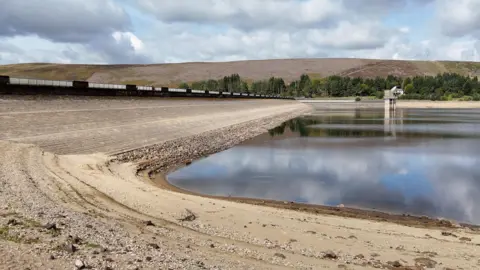 BBC
BBCScotland is known for its rainfall, famed as a lush, green, soggy nation.
Not this year.
Water levels are way below average after the driest spring since 1964 and a hot summer.
The problem is especially acute in the east of the country, where the Scottish Environment Protection Agency (Sepa) is now introducing curbs on some water use.
It said two catchment areas – Ythan in Aberdeenshire and North Fife – had reached significant scarcity, the highest level of alert.
This means the rivers have reached a critical level after being very low for 30 or more days.
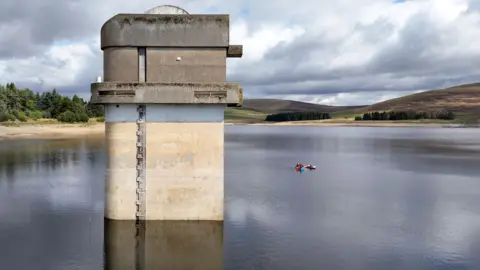
Restrictions are being put into place in the coming days which limit the removal of water from the natural environment around the two rivers for industry and agriculture, a process known as abstraction.
Sepa said that without a period of consistent rainfall, other areas – including the Deveron and the Don in Aberdeenshire – could also escalate to significant scarcity in the coming days.
However, there remains some uncertainty about the impact of the remnants of ex-Hurricane Erin, which is due to bring wetter weather later this week.
Sepa said the restrictions follow “months of worsening conditions”, with every month of 2025 drier than average on Scotland’s east coast.
Scotland has not had a hosepipe ban since 1995 and there are no plans to introduce one.
Supplies are under strain though. Twenty miles north of Dundee, Backwater Reservoir at Glenisla in Angus is less than half full.
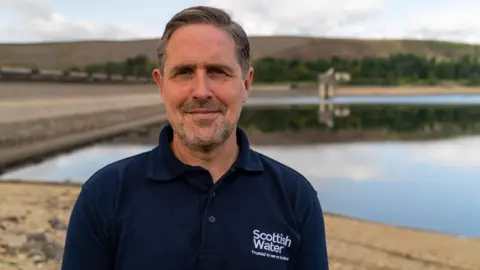
Along with nearby Loch of Lintrathen, the reservoir supplies drinking water to 300,000 people in Scotland’s fourth biggest city and the surrounding area.
It’s worrying, admits Brian McCarthy, economic demand manager at the publicly-owned utility, Scottish Water.
“If this extended dry period continues towards the autumn and winter, then that will be concerning for supplies going into next year and beyond,” he warns.
And Backwater is emptying at an accelerating rate.
As the nation enjoyed late summer sun in August, demand for water jumped by 100 million litres per day from 1,850 million litres to 1,950 million litres.
In response, Scottish Water is considering setting up a temporary network of pipes and pumps to move water into the reservoir from the nearby River Isla.
That would require permission from Sepa which must consider the impact of any such plan on the natural environment.
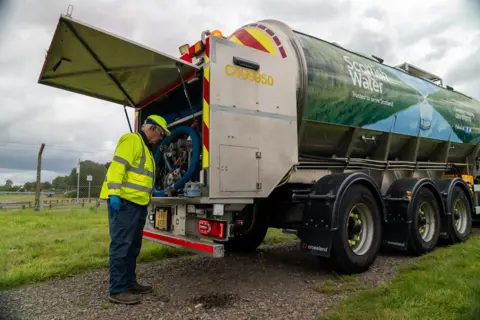
Below Backwater, at the foot of the Angus glens, lies the little town of Kirriemuir – best known as the birthplace of Peter Pan’s creator, JM Barrie.
Last week the underground tank which holds the town’s water supply from Backwater and Lintrathen ran low and had to be topped up by tanker.
The vehicle was one of a fleet of 25 Scottish Water lorries which have been on the move in the past few weeks, shifting supplies around the country.
Often that means moving water from most robust sources in the west of Scotland, which is generally wetter, to the east.
The latest figures from Scottish Water showed the average reservoir levels in the east of Scotland last week were at 56%. That figure at this time of year is usually 81%.
Levels in the west stood at 70% – down from the area’s late summer average of 82%.
The Met Office says the coasts of East Lothian, Fife and the Moray Firth receive less than 700mm of rainfall in an average year, in contrast to the western Scottish Highlands where the annual total exceeds 4,000mm.
Mr McCarthy says that is likely to become a more pressing issue in years to come.
“Our long-term projections show that the population will increase towards the east of the country,” he explains.
Part of the problem, he goes on, is Scotland’s relationship with rain, and the perception that in a land of more than 30,000 freshwater lochs, water must surely be abundant.
This, insists Dr Rebecca Wade, senior lecturer in environmental science at Abertay University in Dundee, is simply not the case.
“Our climate is changing which means that sometimes we have a lot less water than we’re used to having,” she explains.
“Also, when we do get rainfall, it comes in a different pattern.
“So we might get a very intense short storm, and that could even cause localised flooding, but at the same time, it doesn’t resolve the drought situations because it’s not recharging the groundwater. It’s not filling up the reservoirs.”

With that in mind, Scottish Water is trying to persuade its customers to use less water.
In 2023/24, average consumption per person was 140 litres of water in England and Wales compared to 178 litres in Scotland.
One difference is that water is not metered and directly charged in Scotland where purifying, pumping and piping the stuff around is funded through the council tax.
Althought Scottish Water insists there are no plans for that to change, it is running a trial in Dundee involving meters.
Brian McCarthy says the idea is to persuade people to cut back voluntarily by giving them more information about how much water they are using.
Reducing usage, he says, “would have a big impact on the sustainability of supplies for the future.”
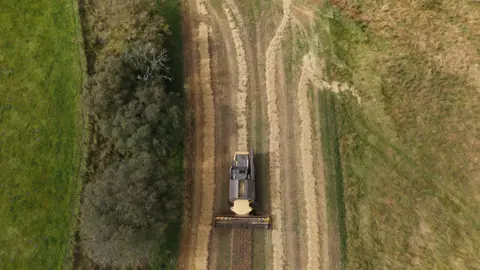
“We’ve got about the same population as the county of Yorkshire in England, but they use 40% less water than we do as a population in Scotland,” says Dr Wade.
One simple solution, she says, is for Scotland to start collecting and using untreated rainwater for watering gardens, washing cars and flushing toilets rather than using precious drinking water.
Not only are we using more water, says Dr Wade, but “as our climate gets drier our industries and our agriculture are needing to draw on more water – so it exacerbates the situation.
“As we draw water from the natural environment it has a big impact on ecology and biodiversity.”
All of this poses a big challenge for agriculture.
On Mairns of Cairnborrow farm near Huntly in Aberdeenshire, the springs which provide drinking water for 240 cattle have run dry, leaving farmer Nicola Wordie literally pushing water uphill.
At least once a day at the moment, she fills a big plastic tank of water and carts it from farm to field in a loader.
“We’re going up at least once if not twice a day to fill this cistern,” she tells me in the cab of the vehicle, explaining that the trips are needed to make sure the cows “have enough water to survive”.
It’s not long since the 1,400 acre farm had the opposite problem, drenched by record-breaking rainfall.
“Last year it was wet for months on end and now it’s the total opposite and we’re dry for months on end,” says Ms Wordie.
“It’s the one extreme to the other.
“We are going to have to adapt.”
Climate scientists call the swings between these extremes weather whiplash and they affect us all.
Parched farmland leads to shortages and pushes up the price of food while falling river levels make water more precious than ever.
“We’re seeing effects on wildlife and the environment, on fish populations, migratory species”, says Dr Wade.
“We’re so lucky in Scotland to have the water resources that we have.
“Now’s the time to start using them more wisely and adapting to climate change so that we don’t end up with more of these extreme situations.”



